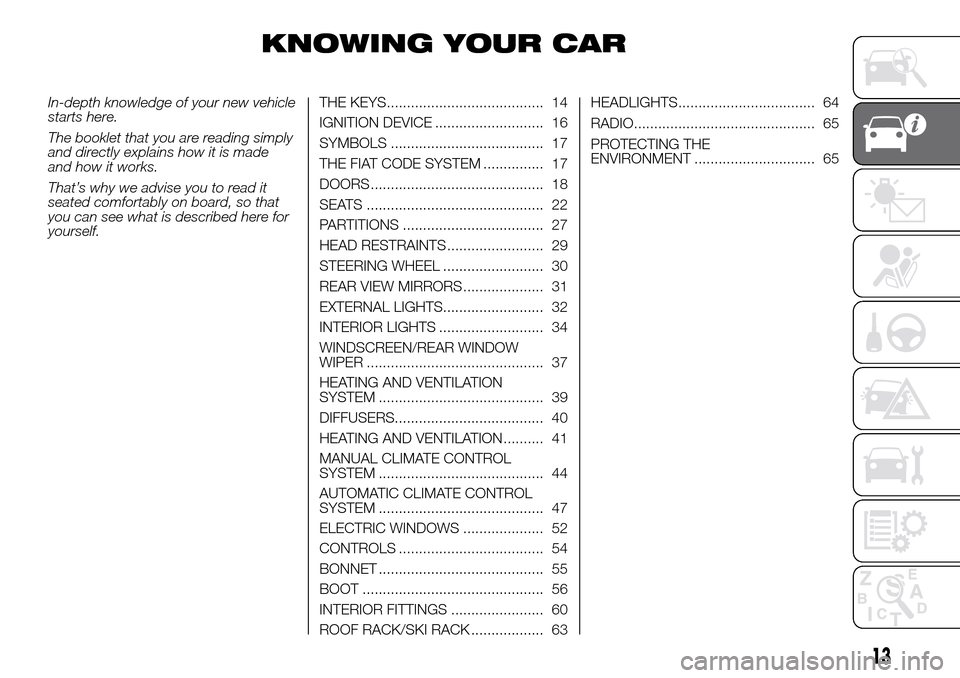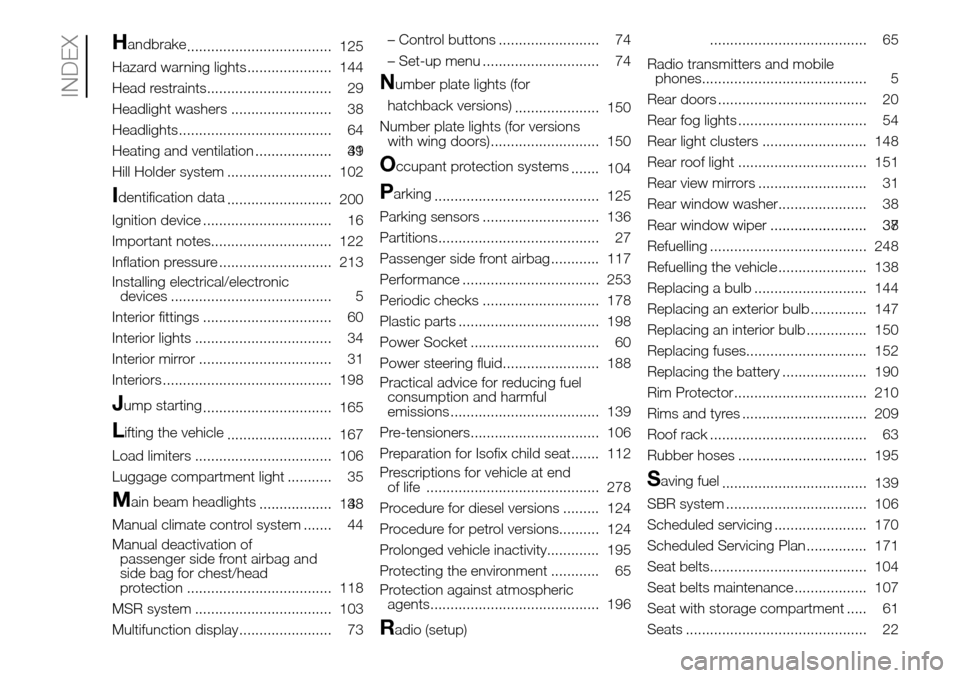roof rack FIAT DOBLO COMBI 2016 2.G Owners Manual
[x] Cancel search | Manufacturer: FIAT, Model Year: 2016, Model line: DOBLO COMBI, Model: FIAT DOBLO COMBI 2016 2.GPages: 298, PDF Size: 25.92 MB
Page 17 of 298

KNOWING YOUR CAR
In-depth knowledge of your new vehicle
starts here.
The booklet that you are reading simply
and directly explains how it is made
and how it works.
That’s why we advise you to read it
seated comfortably on board, so that
you can see what is described here for
yourself.THE KEYS....................................... 14
IGNITION DEVICE ........................... 16
SYMBOLS ...................................... 17
THE FIAT CODE SYSTEM ............... 17
DOORS ........................................... 18
SEATS ............................................ 22
PARTITIONS ................................... 27
HEAD RESTRAINTS ........................ 29
STEERING WHEEL ......................... 30
REAR VIEW MIRRORS .................... 31
EXTERNAL LIGHTS......................... 32
INTERIOR LIGHTS .......................... 34
WINDSCREEN/REAR WINDOW
WIPER ............................................ 37
HEATING AND VENTILATION
SYSTEM ......................................... 39
DIFFUSERS..................................... 40
HEATING AND VENTILATION.......... 41
MANUAL CLIMATE CONTROL
SYSTEM ......................................... 44
AUTOMATIC CLIMATE CONTROL
SYSTEM ......................................... 47
ELECTRIC WINDOWS .................... 52
CONTROLS .................................... 54
BONNET ......................................... 55
BOOT ............................................. 56
INTERIOR FITTINGS ....................... 60
ROOF RACK/SKI RACK .................. 63HEADLIGHTS.................................. 64
RADIO............................................. 65
PROTECTING THE
ENVIRONMENT .............................. 65
13
Page 67 of 298

WARNING
41)Never travel with the glove
compartment open: it could injure the
passenger in the event of a crash.
42)The cigar lighter becomes very hot.
Handle it carefully and make sure that
children don't touch it: risk of fire and/or
burning.
43)Do not use the ashtray as a waste
paper basket: it may catch fire in contact
with cigarette stubs.
ROOF RACK/SKI
RACK
44) 45)
8) 9)
FASTENERS
The fasteners are located at points A, B
and C fig. 109.ROOF RAILS
(for versions/markets, where provided)
On some versions, the vehicle has
two longitudinal bars which, with the
addition of special accessories, can be
used to carry various objects (e.g.
skis, surfboards, etc.).
WARNING
44)Strictly adhere to the laws in force
concerning maximum clearance.
45)Check that the attachment fixing
screws are tight after a few kilometres.
WARNING
8)Evenly distribute the load and take into
account, when driving, the increased
responsiveness of the vehicle to side wind.
9)Never exceed the maximum permitted
loads (see chapter “Technical
specifications”).109F0V0123
63
Page 143 of 298

SAVING FUEL
Some useful tips are given below for
fuel saving and reducing harmful
emissions of CO2 and other pollutants
(nitrogen oxides, unburnt
hydrocarbons, Particulate Matter (PM),
etc.).
PRACTICAL ADVICE FOR
REDUCING FUEL
CONSUMPTION AND
HARMFUL EMISSIONS
Vehicle conditions
Have checks and adjustments for
vehicle maintenancecarried out
in accordance with the “Scheduled
servicing plan”.
Checktyrepressure regularly, at
least once every four weeks.
Excessively low pressures will increase
consumption because rolling resistance
will be higher. In addition, this wears
the tyre more quickly and impairs
performance.
Only usesnow tyreswhen the
weather conditions make them
absolutely necessary. They increase
consumption and noise.
Do not travel witha heavy load: the
weight of the vehicle (especially when
driving in town) and its geometry greatly
affect fuel consumption and stability.
Removeroof racks or ski racks
after use. These accessories reduce the
vehicle's aerodynamic penetration and
have a negative effect on fuel
consumption.
When transporting particularly large
objects, use atrailerif possible.
Use the vehicle's air vents if
possible: travelling with the windows
open impairs aerodynamics.
Use electrical devices only for the
amount of time needed. The vehicle’s
heated rear window, additional
headlights, screen wipers and heater
fan require a considerable amount
of energy; this increases fuel
consumption (by up to +25% in an
urban cycle).
Air conditioning leads to higher fuel
consumption (on average up to +30%).
If the temperature outside is not too
extreme, try and use the air vents.
Driving style
Afterstarting the engineyou
should drive away immediately and
slowly, avoiding high revs. Do not warm
up the engine at low or high revs when
the vehicle is stationary; this causes
the engine to warm up more slowly,
thereby increasing fuel consumption,
emissions and mechanical component
wear.
Avoidpointless actionssuch as
revving up when at traffic lights or
before stopping the engine. The latter
action, like double-declutching, is
unnecessary and causes increased fuel
consumption and pollution.
Gear selection:select a high gear
as soon as possible (taking into
account normal engine operation and
traffic conditions) without pushing
the engine to high revs during
the intermediate gears. Using low gears
at high revs to get lively acceleration
increases fuel consumption, harmful
emissions and engine wear.
Vehicle speed:fuel consumption
increases exponentially as the speed of
the vehicle increases. Keep your speed
moderate and as even as possible,
avoiding unnecessary braking and
acceleration, which cause excessive
fuel consumption and increased
emissions. Keeping a safe distance
from the vehicle in front helps to
maintain a steady speed.
Acceleration:accelerating violently
severely affects consumption and
emissions. Acceleration should be
gradual and should not exceed the
maximum engine torque rate.
139
Page 258 of 298

FUEL
CONSUMPTION
The fuel consumption figures given in
the tables below are determined on the
basis of the type-approval tests laid
down by specific European Directives.
These consumption values refer to
basic vehicles without optionals.
The following procedures are used to
measure the fuel consumption:
urban cycle: begins with cold
starting, followed by driving simulating
the use of the vehicle in town;
extra-urban cycle: driving that
simulates using the vehicle out of town
with frequent acceleration in all gears;
the speed varies from 0 to 120 km/h;
combined fuel consumption:
calculated with a weighting of
approximately 37% of the urban cycle
and 63% of the extra-urban cycle.
IMPORTANT The type of route, traffic
situations, weather conditions, driving
style, general conditions of the vehicle,
trim level/equipment/accessories,
climate control system, vehicle load,
roof rack, other situations that affect
aerodynamics or air drag may lead to
different fuel consumption levels than
those measured.WARNING
In practice, fuel consumption may be
higher than the values obtained during
the approval tests.
Here are some of the major factors that
can lead to a difference between test
and real consumption.
1) Vehicle condition: inadequate
servicing, use of roof racks, trailers,
heavy loading, high usage of electrical
devices and the air conditioning.
2) Driving style: frequent cold starts for
short journeys, poor engine warming
technique, gear selection, high speeds,
sudden acceleration and braking.
3) Traffic and road conditions: driving in
traffic, steep hills or winding roads,
road surface conditions.
4) Atmospheric conditions: intemperate
weather, wind, rain, snow, high altitude.
5) Proportion of use in towns and
cities, in the country and on
motorways.PRACTICAL ADVICE FOR
REDUCING FUEL
CONSUMPTION AND
HARMFUL EMISSIONS
Vehicle conditions
1. Have checks and adjustments
carried out in accordance with the
“Scheduled Servicing Plan”.
2. Check tyre pressure regularly, at least
once every four weeks. Excessively
low pressures will increase
consumption because rolling resistance
will be higher. In addition, this wears
the tyre more quickly and impairs
performance.
3. Only use snow tyres when the
weather conditions make them
absolutely necessary. They increase
consumption and noise.
4. Do not travel with a heavy load: the
weight of the vehicle (especially when
driving in town) and its trim greatly
affect fuel consumption and stability.
5. Remove roof racks or ski racks after
use. These accessories reduce the
vehicle's aerodynamic penetration and
have a negative effect on fuel
consumption.
6. When transporting particularly large
objects, use a trailer if possible.
7. Use the vehicle's air vents if possible:
travelling with the windows open
impairs aerodynamics.
254
TECHNICAL DATA
Page 295 of 298

Handbrake
.................................... 125
Hazard warning lights..................... 144
Head restraints............................... 29
Headlight washers ......................... 38
Headlights...................................... 64
Heating and ventilation ................... 39................... 41
Hill Holder system .......................... 102
Identification data
.......................... 200
Ignition device ................................ 16
Important notes.............................. 122
Inflation pressure ............................ 213
Installing electrical/electronic
devices ........................................ 5
Interior fittings ................................ 60
Interior lights .................................. 34
Interior mirror ................................. 31
Interiors .......................................... 198
Jump starting
................................ 165
Lifting the vehicle
.......................... 167
Load limiters .................................. 106
Luggage compartment light ........... 35
Main beam headlights
.................. 33 .................. 148
Manual climate control system ....... 44
Manual deactivation of
passenger side front airbag and
side bag for chest/head
protection .................................... 118
MSR system .................................. 103
Multifunction display....................... 73– Control buttons ......................... 74
– Set-up menu ............................. 74
Number plate lights (for
hatchback versions)
..................... 150
Number plate lights (for versions
with wing doors)........................... 150
Occupant protection systems
....... 104
Parking
......................................... 125
Parking sensors ............................. 136
Partitions........................................ 27
Passenger side front airbag ............ 117
Performance .................................. 253
Periodic checks ............................. 178
Plastic parts ................................... 198
Power Socket ................................ 60
Power steering fluid........................ 188
Practical advice for reducing fuel
consumption and harmful
emissions ..................................... 139
Pre-tensioners................................ 106
Preparation for Isofix child seat....... 112
Prescriptions for vehicle at end
of life ........................................... 278
Procedure for diesel versions ......... 124
Procedure for petrol versions.......... 124
Prolonged vehicle inactivity............. 195
Protecting the environment ............ 65
Protection against atmospheric
agents.......................................... 196
Radio (setup)....................................... 65
Radio transmitters and mobile
phones......................................... 5
Rear doors ..................................... 20
Rear fog lights ................................ 54
Rear light clusters .......................... 148
Rear roof light ................................ 151
Rear view mirrors ........................... 31
Rear window washer...................... 38
Rear window wiper ........................ 37........................ 38
Refuelling ....................................... 248
Refuelling the vehicle ...................... 138
Replacing a bulb ............................ 144
Replacing an exterior bulb .............. 147
Replacing an interior bulb ............... 150
Replacing fuses.............................. 152
Replacing the battery ..................... 190
Rim Protector................................. 210
Rims and tyres ............................... 209
Roof rack ....................................... 63
Rubber hoses ................................ 195
Saving fuel
.................................... 139
SBR system ................................... 106
Scheduled servicing ....................... 170
Scheduled Servicing Plan ............... 171
Seat belts....................................... 104
Seat belts maintenance .................. 107
Seat with storage compartment ..... 61
Seats ............................................. 22
INDEX
Page 297 of 298

We really know your car because we invented, designed and built it: we really know every single detail.
At Fiat Service authorised workshopsyou can find technicians directly trained by us,
offering quality and professionalism for all service operations.
Fiat workshops are always close to you for the regular servicing operations, season checks
and practical recommendations by our experts.
With Original Parts distributed by MOPAR
®, you maintain the reliability, comfort
and performance features that you bought your new car for over time.
Always ask for Genuine Parts for the components used on our cars; we recommend them because
they come from our steady commitment in research and development of highly innovative technologies.
For all these reasons: rely on Genuine Parts, because they are the only ones designed
by FCA for your car.
SAFETY:
BRAKING SYSTEMENVIRONMENT: PARTICULATE FILTERS,
CLIMATE CONTROL MAINTENANCECOMFORT: SUSPENSION
AND WINDSCREEN WIPERS PERFORMANCE: SPARK PLUGS,
INJECTORS AND BATTERIESLINEACCESSORI
ROOF RACK BARS, WHEEL RIMS
WHY CHOOSING
GENUINE PARTS
This Owner Handbook is intended to show the vehicle's operating conditions.
For the enthusiast user who wants to have insights, curiosities and detailed information about the characteristics and functions
of the vehicle, Fiat gives the opportunity to consult a dedicated section which is available in electronic format.
ONLINE VEHICLE OWNER HANDBOOK
The following symbol is reported within the text of the Owner Handbook, next to the subjects for which details are provided.
Go to the www.mopar.eu/owner
website and access your personal area.
The “Maintenance and care” page includes all the information about your vehicle and the link to access eLUM, where you will find
all the details of the Owner Handbook.
Alternatively, to access this information, go to the Internet website at http://aftersales.fiat.com/elum/
.
The eLUMwebsite is free and will allow you, among many other things, to easily consult the on-board documents
of all the other vehicles of the Group.
Have a nice reading and happy motoring!
Cop TIPO LUM GB.qxp_500 UM ITA 02/12/15 09:34 Pagina 2